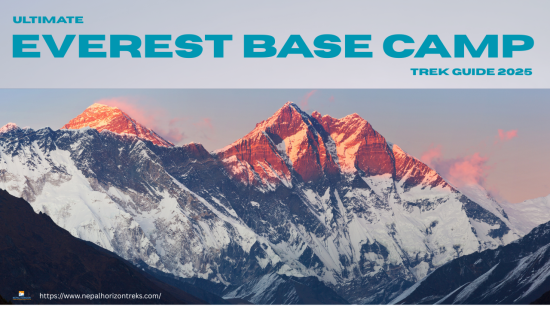Trek to Everest Base Camp: A Once-in-a-Lifetime Himalayan Adventure
14th October 2025
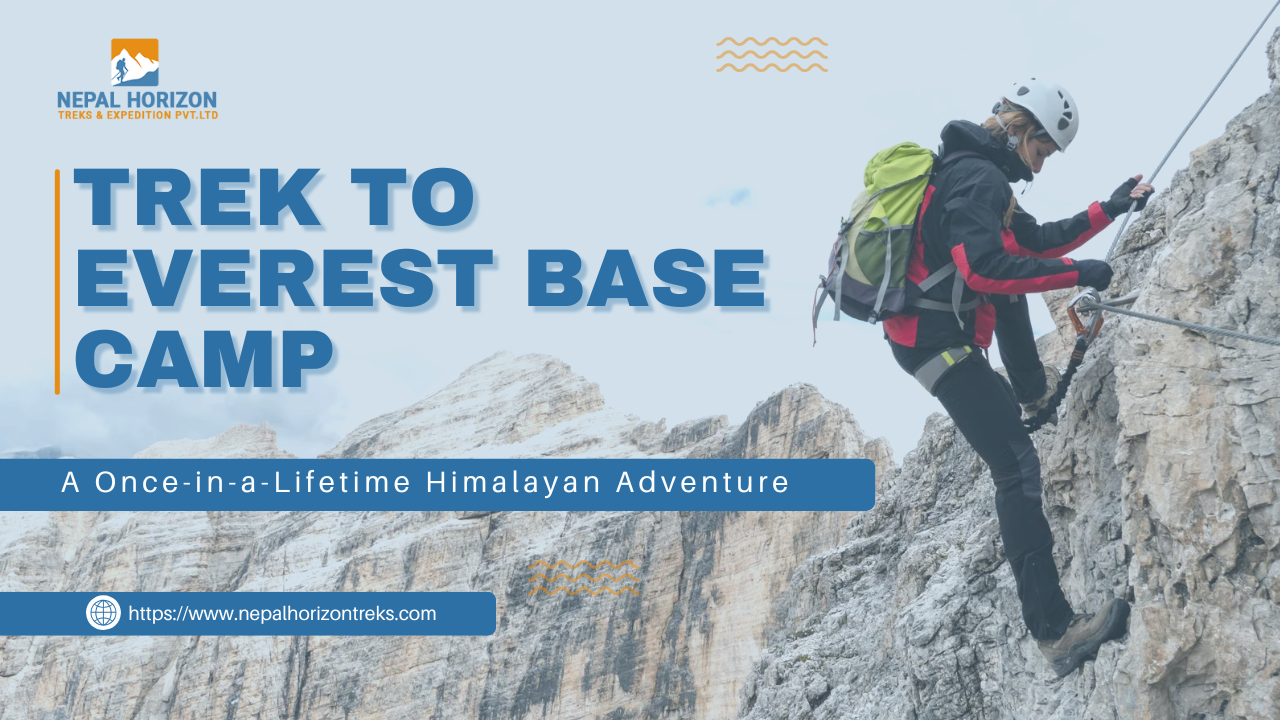
Introduction
The Everest Base Camp trek is more than just a journey — it’s a dream adventure for travelers around the world. Nestled deep in the heart of the Himalayas, this trek takes you to the foot of Mount Everest (8,848.86 m), the highest peak on Earth. Every step through the rugged trails, Sherpa villages, and glacial valleys offers an unforgettable experience of Nepal trekking at its finest.
If you’re searching for a true Himalaya adventure, the EBC trek (Everest Base Camp trek) promises breathtaking scenery, cultural encounters, and personal triumph. Whether you’re an experienced trekker or a first-time adventurer, this trail is where dreams touch the sky.
Overview of the Everest Base Camp Trek
The Everest Base Camp (EBC) trek is one of the most iconic trekking routes in the world. It starts with a thrilling flight from Kathmandu to Lukla — a short yet exhilarating journey that drops you right into the Himalayas. From there, the adventure unfolds through vibrant Sherpa villages, suspension bridges, and Buddhist monasteries, eventually leading to Kala Patthar (5,545m), the best vantage point for panoramic views of Everest.
- Maximum Altitude: 5,545 meters (Kala Patthar)
- Trek Duration: 12–16 days
- Best Season: Spring (March–May) and Autumn (September–November)
- Trek Region: Khumbu Region, Sagarmatha National Park
This journey isn’t just about reaching a destination — it’s about embracing the experience, the people, and the stunning Himalayan landscapes that define Nepal trekking.
Best Time to Trek to Everest Base Camp
Timing plays a vital role in your Everest Base Camp experience. The best seasons for trekking are:
1. Spring (March to May)
This is the most popular trekking season. The trails bloom with rhododendrons, the skies are clear, and temperatures are moderate. Spring also offers excellent visibility for mountain photography.
2. Autumn (September to November)
Autumn brings stable weather, crisp air, and crystal-clear mountain views. It’s the ideal time for an EBC trek guide-recommended journey due to comfortable temperatures and fewer flight delays.
3. Winter (December to February)
Winter offers solitude and serenity, though it’s colder and some routes may be snow-covered. It’s perfect for trekkers seeking a quieter trail.
4. Summer (June to August)
The monsoon months bring rain and cloud cover, but lush greenery and fewer crowds appeal to some adventurers.
Everest Base Camp Itinerary (12–16 Days)
A typical Everest Base Camp itinerary lasts between 12 and 16 days, depending on acclimatization and travel preferences. Here’s a general outline:
Day 1: Fly to Lukla (2,840m) – Trek to Phakding (2,610m)
Enjoy a short flight from Kathmandu to Lukla, one of the world’s most thrilling airstrips. Trek along the Dudh Koshi River to reach Phakding.
Day 2: Phakding to Namche Bazaar (3,440m)
Cross suspension bridges, pass pine forests, and enter Namche Bazaar, the vibrant trading hub of the Khumbu region.
Day 3: Acclimatization Day in Namche Bazaar
Explore local markets, visit the Sherpa Museum, and enjoy views of Everest, Ama Dablam, and Lhotse.
Day 4: Namche to Tengboche (3,870m)
Trek through forested trails to reach Tengboche Monastery, one of the most spiritual spots on the route.
Day 5: Tengboche to Dingboche (4,410m)
Pass through Pangboche village and witness magnificent views of Ama Dablam.
Day 6: Acclimatization Day in Dingboche
Rest and explore nearby ridges for acclimatization. A short hike to Nagarjun Hill is recommended.
Day 7: Dingboche to Lobuche (4,910m)
Follow the Khumbu Glacier and pass the Everest Memorials dedicated to climbers.
Day 8: Lobuche to Gorak Shep (5,164m) – Trek to Everest Base Camp (5,364m)
Reach Everest Base Camp, the heart of your Himalayan journey. Capture photos and soak in the sense of achievement.
Day 9: Hike to Kala Patthar (5,545m) – Descend to Pheriche (4,240m)
An early morning climb rewards you with the best sunrise over Everest. Descend afterward for an easier night.
Day 10–12: Return to Lukla via Tengboche and Namche
Retrace your steps through familiar trails, cherishing your Everest Base Camp experience.
Day 13–16: Fly back to Kathmandu and relax
Celebrate your successful journey and explore the capital before heading home.
Trekking Route and Major Stops
The EBC trek route follows the famous Khumbu Valley, where nature and culture coexist beautifully. Some key highlights include:
- Lukla: The starting point of the trek, famous for its scenic airport.
- Namche Bazaar: A bustling Sherpa town with cafes, shops, and mountain views.
- Tengboche: Home to the largest monastery in the region.
- Dingboche & Lobuche: High-altitude villages offering acclimatization stops.
- Gorak Shep & Kala Patthar: Final base before reaching the iconic Everest Base Camp.
Each stop presents unique experiences — from sipping yak butter tea with locals to viewing Everest’s mighty face up close.
Accommodation and Meals
Along the trail, trekkers stay in teahouses — cozy lodges run by Sherpa families offering basic yet comfortable amenities. Rooms typically include twin beds, blankets, and shared bathrooms.
Meals: Expect traditional Nepali dishes like dal bhat, noodles, momos, and soups. Many teahouses also serve pancakes, pasta, and hot drinks. Staying hydrated and eating nutritious food is key for altitude endurance.
Trekking Difficulty and Fitness Requirements
The Everest Base Camp trek is considered moderate to challenging. It doesn’t require technical climbing, but stamina and preparation are essential. You’ll be trekking 5–7 hours daily on steep and rugged trails.
Fitness Tips:
- Train with regular hikes and cardio exercises before the trek.
- Acclimatize properly to avoid altitude sickness.
- Walk at a steady pace and stay hydrated.
With a positive mindset and proper guidance, anyone with basic fitness can complete the EBC trek successfully.
Cultural Experiences and the Sherpa Community
A highlight of this Himalaya adventure is connecting with the local Sherpa community, known for their warmth, spirituality, and mountaineering legacy. Sherpas are deeply rooted in Buddhist traditions — prayer flags, mani stones, and stupas line the path.
Visiting Tengboche Monastery provides insight into local rituals, chants, and Himalayan beliefs. The hospitality of the Sherpas adds a soulful touch to your Everest Base Camp experience.
Safety, Permits, and Guidelines
Before starting the Everest Base Camp trek, ensure you have the necessary permits and follow safety regulations.
Required Permits:
- Sagarmatha National Park Entry Permit – NPR 3,000
- Khumbu Pasang Lhamu Rural Municipality Permit – NPR 2,000
Permits can be obtained in Kathmandu or at the entry points of the Khumbu region.
Safety Guidelines:
- Always trek with a licensed guide.
- Stay aware of altitude sickness symptoms.
- Carry basic first aid and ensure your travel insurance covers high-altitude trekking.
- Avoid rushing — acclimatization is the key to a safe trek.
Nepal Horizon Trek offers customized EBC trek packages with expert guides ensuring both safety and adventure throughout your journey.
Gear and Packing Tips
Packing the right gear ensures comfort and safety on your Everest Base Camp itinerary.
Essentials:
- Trekking boots (waterproof and broken-in)
- Warm down jacket and layers
- Sleeping bag (good for -10°C)
- Trekking poles
- Gloves, hats, and thermal wear
- Water purification tablets
- Sunglasses and sunscreen
- Power bank and extra batteries
You can rent or buy most equipment in Kathmandu or Namche Bazaar.
Cost and Travel Recommendations
The cost of an Everest Base Camp trek varies based on group size, route, and service type. On average:
- Standard 14-day trek: USD 1,200 – 1,800 per person
- Luxury lodge trek: USD 2,000 – 2,800 per person
The package usually includes accommodation, meals, domestic flights, permits, guide/porter services, and transfers.
For a hassle-free experience, plan your Everest Base Camp adventure with Nepal Horizon Trek today!
We handle everything — from logistics and permits to accommodation and expert local guides — so you can focus on the journey.
Conclusion
The Everest Base Camp trek is more than a physical challenge — it’s a spiritual journey through the world’s most majestic mountains. Each sunrise over Everest reminds you of nature’s grandeur and your own resilience. Whether it’s the sound of prayer flags fluttering or the smiles of Sherpa children, every moment etches itself into your memory.
If you’re ready for a Himalaya adventure that changes how you see the world, Nepal Horizon Trek is your trusted companion.
Contact Us Today! Our expert team is here to craft the perfect itinerary, handle all logistics, and ensure your journey is safe, memorable, and meaningful.
📞 Phone: +9779851183849
📧 Email: info@nepalhorizontreks.com
📍 Location: Thamel, Chhetrapati, Kathmandu, Nepal
Start your Himalayan dream with us — your adventure begins here!
FAQs About the Everest Base Camp Trek
1. How long does the Everest Base Camp trek take?
Typically, the trek lasts 12–16 days, depending on your pace and acclimatization schedule.
2. What is the best time for the EBC trek?
The best months are March–May (spring) and September–November (autumn), offering the best weather and mountain views.
3. How difficult is the Everest Base Camp trek?
It’s a moderate to challenging trek. While no technical skills are required, good fitness and preparation are important.
4. Do I need permits for the EBC trek?
Yes, you need two permits — the Sagarmatha National Park Entry Permit and the Khumbu Pasang Lhamu Rural Municipality Permit.
5. What kind of accommodation can I expect?
You’ll stay in teahouses, which are local lodges providing basic facilities, meals, and warm hospitality.
6. Can I do the trek solo?
Solo trekking is possible but not recommended for beginners. Hiring a guide through a trusted company like Nepal Horizon Trek ensures safety and a richer experience.
Recent From Blogs

14th October 2025

12th October 2025
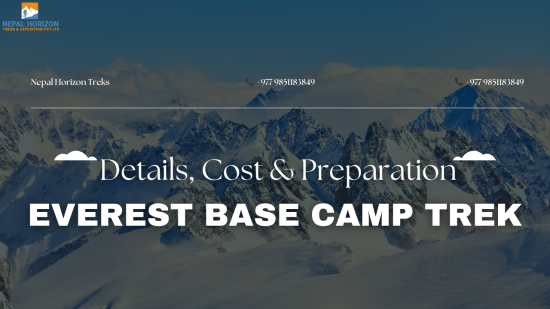
10th October 2025

7th October 2025

27th September 2025
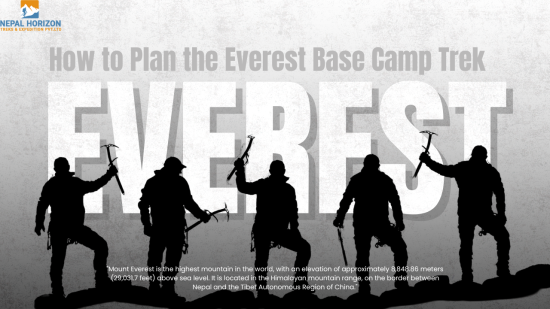
25th September 2025

22nd September 2025
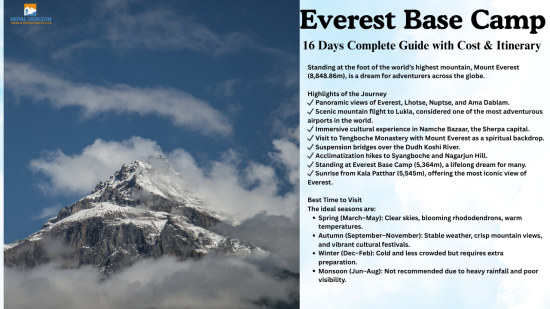
20th September 2025

17th September 2025
